You are using an out of date browser. It may not display this or other websites correctly.
You should upgrade or use an alternative browser.
You should upgrade or use an alternative browser.
OpenEVSE - Open Source Charging Station
- Thread starter chris1howell
- Start date

Help Support My Nissan Leaf Forum:
This site may earn a commission from merchant affiliate
links, including eBay, Amazon, and others.
fotajoye
Well-known member
You may want to contact evseupgrade.com and see if Phil can make you a real, build, deal.
Ingineer
Well-known member
We are now getting email requests for kits/parts, etc. Sorry people, we do not offer kits or parts. There is simply too much liability for this, and some A**hole will sue us and that will be the end of our assistance to the EV community. Please do not email us asking for assistance with this, we are far too busy as it is just trying to help people get an already-assembled low-cost charging solution.fotajoye said:You may want to contact evseupgrade.com and see if Phil can make you a real, build, deal.
I applaud Chris for his efforts and am glad this project exists! If you are qualified to construct a DIY EVSE, then more power to you (or literally to your car!), but please, if you don't have extensive experience with electronics and high-voltage, please don't take on a project like this just to save a few bucks. It could cost you or someone else their lives, and if news got out, even that there was a little smoke involved, the negative publicity could really hurt our new burgeoning EV movement!
-Phil
padamson1
Well-known member
Ingineer said:I applaud Chris for his efforts and am glad this project exists! If you are qualified to construct a DIY EVSE, then more power to you (or literally to your car!), but please, if you don't have extensive experience with electronics and high-voltage, please don't take on a project like this just to save a few bucks. It could cost you or someone else their lives, and if news got out, even that there was a little smoke involved, the negative publicity could really hurt our new burgeoning EV movement!
-Phil
+20. While it is nuts that companies are charging so much for what is simply an extension cord with some safety smarts, it's not worth endangering your warranty, possibly frying your LEAF and/or yourself just to save a couple 100 bucks!!!
Right now the LeGrand L1 EVSE is $499 at Home Depot, it features a waterproof case, right angle plug, and variable charge rate control. Their L2 charger is $749 (also @ Home Depot) looks sharp on the wall and has a nice self coiling cord. If there are 2 open slots on your house panel, one can DIY the L2 install themselves (without any training other than common sense shutting off the panel) and save the same money they would with Chris' kit. If there isn't room on the panel having an open EVSE doesn't really save much anyway as you've got more expensive problems to handle...
Ingineer
Well-known member
Keep in mind, by the time you spend $20,000+ on getting your UL listing, and all the NRE and one-time charges, such as injection molding tooling, you have to spread these costs out over your sales. That's why these units are so expensive, not because these companies are greedy.padamson1 said:While it is nuts that companies are charging so much for what is simply an extension cord with some safety smarts, it's not worth endangering your warranty, possibly frying your LEAF and/or yourself just to save a couple 100 bucks!!!
I have an excellent design for a simple, durable, and portable all-voltage EVSE with excellent features, but unfortunately it quickly falls victim to all this business reality when we realize that we could only sell a few thousand units at best over the next few years.
-Phil
padamson1
Well-known member
Well put Phil.Ingineer said:Keep in mind, by the time you spend $20,000+ on getting your UL listing, and all the NRE and one-time charges, such as injection molding tooling, you have to spread these costs out over your sales. That's why these units are so expensive, not because these companies are greedy.padamson1 said:While it is nuts that companies are charging so much for what is simply an extension cord with some safety smarts, it's not worth endangering your warranty, possibly frying your LEAF and/or yourself just to save a couple 100 bucks!!!
I have an excellent design for a simple, durable, and portable all-voltage EVSE with excellent features, but unfortunately it quickly falls victim to all this business reality when we realize that we could only sell a few thousand units at best over the next few years.
-Phil
Perhaps my phrasing would have been better as "While it may seem nuts..."
Personally I'm OK with $500(L1) and $750(L2) that Home Depot is charging for the Legrand EVSEs. I wish I had seen that before I paid $150 more for the Clipper Creek that doesn't have the variable charge control that I'd like when I visit someone with older wiring, but I can still live with it.
surfingslovak
Well-known member
- Joined
- Jun 13, 2011
- Messages
- 3,809
Interesting discussion, and nice looking EVSE design, Ingineer.fotajoye said:Thanks for the info; what can Carbon World do for the forum members, pricewise? What units would you recomend?
But back to the topic of this thread. Fotajoye, I was hoping Kevin would reply to your question directly. In the meantime, please have a look at the Leaf forum in the UK. Kevin stated there that he expected the initial price point for the J1772 to Mennekes cable to be £200. This cable has an extra connector we wouldn't need in the US. It has a European CE label as well, which wouldn't apply here either. Which reminds me, is the Dostar plug UL listed? Should it be?
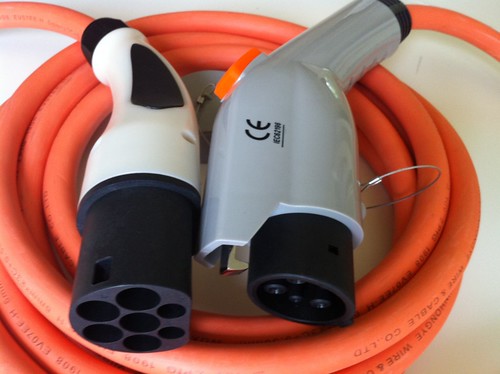
Click to enlarge
fotajoye
Well-known member
My recent quote from one of the J1772 Chinese factories is $81 for 100, 5 meter units FOB. God! what would I do with $8,100 worth of cable plugs. And, what would be the shipping and customs costs? What would we pay if they were made here? This is a no deal so far. At this point even the DIY unit is expensive because of of the J772 cable.
I suggested the Chinese company open an eBay store...that didn't go over very well! (ha).
In time as EVs populate the roads, perhaps EVSEs will reach a fair price because of the economics of scale. $750 is still way too much for the L2 Home Depot unit.
I see the best deal is still provided by Phil's mod that allows the in car charger to work on 120/240volts.
I suggested the Chinese company open an eBay store...that didn't go over very well! (ha).
In time as EVs populate the roads, perhaps EVSEs will reach a fair price because of the economics of scale. $750 is still way too much for the L2 Home Depot unit.
I see the best deal is still provided by Phil's mod that allows the in car charger to work on 120/240volts.
fotajoye
Well-known member
@ingineer:
Thanks, I'll look at the UK site; Don't know if the plugs are UL; didn't get that far
BTW, It would be great if someone would start a a U.S. Zero Carbon World; Kevin already has a model; Lets see 100 pounds is what? about 300USD?
Thanks, I'll look at the UK site; Don't know if the plugs are UL; didn't get that far
BTW, It would be great if someone would start a a U.S. Zero Carbon World; Kevin already has a model; Lets see 100 pounds is what? about 300USD?
chris1howell
Well-known member
I had a chance to work on the touchscreen LCD this weekend.
This is the basic idea...
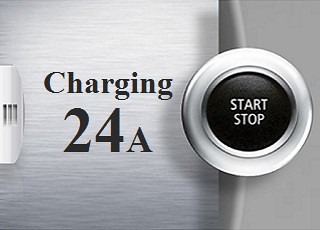
example by chris1howell, on Flickr
Implemented in hardware...The text overlay font is kinda ugly, but it works for now.
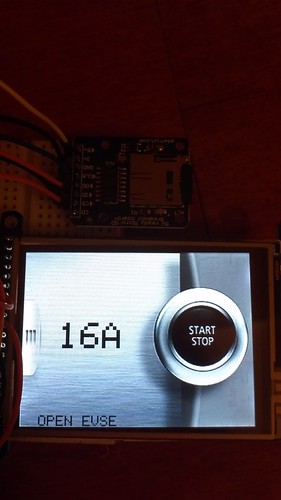
2011-11-13_22-31-45_205 by chris1howell, on Flickr
MicroSD card for the graphics...
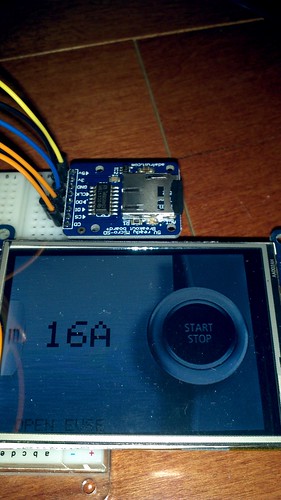
2011-11-13_22-32-06_487 by chris1howell, on Flickr
This is the basic idea...

example by chris1howell, on Flickr
Implemented in hardware...The text overlay font is kinda ugly, but it works for now.

2011-11-13_22-31-45_205 by chris1howell, on Flickr
MicroSD card for the graphics...

2011-11-13_22-32-06_487 by chris1howell, on Flickr
chris1howell said:I had a chance to work on the touchscreen LCD this weekend.
This is the basic idea...
This is great! Now I want one even more....
edatoakrun
Well-known member
Ingineer said:Keep in mind, by the time you spend $20,000+ on getting your UL listing, and all the NRE and one-time charges, such as injection molding tooling, you have to spread these costs out over your sales. That's why these units are so expensive, not because these companies are greedy.
I have an excellent design for a simple, durable, and portable all-voltage EVSE with excellent features, but unfortunately it quickly falls victim to all this business reality when we realize that we could only sell a few thousand units at best over the next few years.

-Phil
Yes, any reasonably priced EVSE will not be profitable for the next few years, by selling only a few thousand units annually.
But how many million dollars has TESLA burned through, in how many years, an endeavor with (IMO) far less likelihood of success?
You are in a fairly unique position, Phil, of understanding both EVSE design, and the market features (which none of the current offerings have) that will soon be required in a marketable EVSE, that will sell in large numbers, profitably.
I would suggest you consider seeking capital, to allow you to get your design into production.
UhClem
Well-known member
- Joined
- May 23, 2010
- Messages
- 107
I've been looking this for a bit and have a few random comments and questions.
- Besides replacing SMD components with thru hole components, are there other differences between the board layout in Open EVSEv1 TH.brd and the boards in the photos?
- Has anyone made boards from the .dru yet?
- I haven't played with EAGLE much yet so I might just be confused, but it looks to me like most or all of the GND traces are missing from the layout.
- Why not make the .sch file available, too? Or the whole project? That would make it easier to make changes
- Why not put the EAGLE files in svn and just have latest official "releases" in the Downloads section?
- Any plans to add GFCI to the board layout? If I had a .sch to work from, I'd do that
- The surge suppressor (TVS) is missing from the parts list and the value (P6KE16A) is missing from the schematic w/GFCI. It is on the schematic w/o GFCI.
chris1howell
Well-known member
Here is a the first through hole board based on the Open EVSE. Once i finish testing I may offer a few boards or maybe even a board/parts kit (at a very reasonable price) to help offset the hardware devolopment costs.
This board has a +-12V DC\DC converter added so all thats required to power it is a 12V supply.

2011-11-15_19-35-44_26 by chris1howell, on Flickr
This board has a +-12V DC\DC converter added so all thats required to power it is a 12V supply.

2011-11-15_19-35-44_26 by chris1howell, on Flickr
chris1howell
Well-known member
I've been looking this for a bit and have a few random comments and questions.
Besides replacing SMD components with thru hole components, are there other differences between the board layout in Open EVSEv1 TH.brd and the boards in the photos?
Has anyone made boards from the .dru yet?
I haven't played with EAGLE much yet so I might just be confused, but it looks to me like most or all of the GND traces are missing from the layout.
Why not make the .sch file available, too? Or the whole project? That would make it easier to make changes
Why not put the EAGLE files in svn and just have latest official "releases" in the Downloads section?
Any plans to add GFCI to the board layout? If I had a .sch to work from, I'd do that
The surge suppressor (TVS) is missing from the parts list and the value (P6KE16A) is missing from the schematic w/GFCI. It is on the schematic w/o GFCI.
Thanks for the input UhClem, send me your Google account name and I will add you to the project if you would like to participate.
The biggest difference is the old boards use several logic gates for a hardware GFCI, Open EVSE is using an interupt routine on the Microprocessor.
Yep see the post above. There were a few problems with the original file, EAGLE error pins close but not connecting leaving a couple traces out. I have fixed the problem and uploaded new BRD files.
There are no traces for ground beacuse the whole board has a ground plane top and bottom.
SCH files are up now.
BRD file for the GFCI board is up, I wanted to build the non GFCI board first so I could fix the problems.
Fixed the TVS label and added it to the parts list.
UhClem
Well-known member
- Joined
- May 23, 2010
- Messages
- 107
Nice.chris1howell said:This board has a +-12V DC\DC converter added so all thats required to power it is a 12V supply.
After spending a few hours looking for a nice, cheap +12V/-12V universal supply, I was thinking about doing the same thing
chris1howell
Well-known member
Here is the Open EVSE without GFCI built with small surface mount components. Its less than 2" but 2" and requires only a simple 12V supply. The Board with GFCI is only about 1/4" wider.

2011-11-18_07-34-42_611 by chris1howell, on Flickr
Prototype boards history.
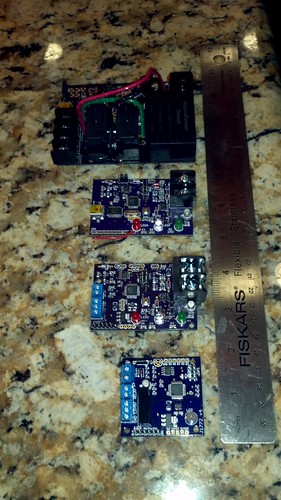
2011-11-17_21-13-09_305 by chris1howell, on Flickr
Ready for Solder...

2011-11-17_20-02-52_385 by chris1howell, on Flickr
Solder paste applied. I use the same mask for both GFCI and non GFCI boards.

2011-11-17_20-06-02_169 by chris1howell, on Flickr
Placing the components.

2011-11-17_20-49-03_523 by chris1howell, on Flickr
Time to cook...

2011-11-17_20-49-43_277 by chris1howell, on Flickr
Through hole components are added.

2011-11-17_21-13-16_333 by chris1howell, on Flickr

2011-11-18_07-34-42_611 by chris1howell, on Flickr
Prototype boards history.

2011-11-17_21-13-09_305 by chris1howell, on Flickr
Ready for Solder...

2011-11-17_20-02-52_385 by chris1howell, on Flickr
Solder paste applied. I use the same mask for both GFCI and non GFCI boards.

2011-11-17_20-06-02_169 by chris1howell, on Flickr
Placing the components.

2011-11-17_20-49-03_523 by chris1howell, on Flickr
Time to cook...

2011-11-17_20-49-43_277 by chris1howell, on Flickr
Through hole components are added.

2011-11-17_21-13-16_333 by chris1howell, on Flickr
garygid
Well-known member
Chris, more great work, and I am very proud of you!
Would you post a little education about using solder paste,
and what works for a "cooker", please?
Happy Thanksgiving to you and your family.
Cheers, Gary
Would you post a little education about using solder paste,
and what works for a "cooker", please?
Happy Thanksgiving to you and your family.
Cheers, Gary
chris1howell
Well-known member
No problem Gary...
I start by designing the board in EAGLE from Cadsoft http://www.cadsoftusa.com/. I would suggest starting with 1206 SMD components, as it is not too hard to read the values and they are not too hard to place. I am currently using 805, which are a lot harder to read but still not too hard to place.
I send the processed files (Gerbers) to DorkBotPDX http://dorkbotpdx.org/wiki/pcb_order. They send out orders for production on Mondays, It takes about 2 weeks to get the boards back. They cost $5 per sq/in for 3 copies of your board, shipping is free.
I also send the Gerbers to OHARARP LLC to get the solder mask made, this saves so much time and hassle. I hand soldered the first few boards and gladly spend the $25 for the stencil. http://www.ohararp.com/Stencils.html
Once the board, stencils and components arrive I begin the stenciling. Spark fun has a great video tutorial.
[youtube]http://www.youtube.com/watch?v=WDIqtGMROjM[/youtube]
The skillet is nothing special, I just took the one in the kitchen already. I do not use it for food anymore. Just throw the board/boards in, plug in and set to the max temperature and put the lid on. In about 2 minutes the paste will melt and flow. After all the solder on the board has melted and flowed nicely, unplug and carefully remove the hot components and allow them the cool. Some people prefer a modified toaster oven but the skillet works well for me.
Sparkfun has a tutorial about reflow soldering. http://www.sparkfun.com/tutorials/59
If we can find a suitable location I would be happy to do a demo next time I head your way.
I start by designing the board in EAGLE from Cadsoft http://www.cadsoftusa.com/. I would suggest starting with 1206 SMD components, as it is not too hard to read the values and they are not too hard to place. I am currently using 805, which are a lot harder to read but still not too hard to place.
I send the processed files (Gerbers) to DorkBotPDX http://dorkbotpdx.org/wiki/pcb_order. They send out orders for production on Mondays, It takes about 2 weeks to get the boards back. They cost $5 per sq/in for 3 copies of your board, shipping is free.
I also send the Gerbers to OHARARP LLC to get the solder mask made, this saves so much time and hassle. I hand soldered the first few boards and gladly spend the $25 for the stencil. http://www.ohararp.com/Stencils.html
Once the board, stencils and components arrive I begin the stenciling. Spark fun has a great video tutorial.
[youtube]http://www.youtube.com/watch?v=WDIqtGMROjM[/youtube]
The skillet is nothing special, I just took the one in the kitchen already. I do not use it for food anymore. Just throw the board/boards in, plug in and set to the max temperature and put the lid on. In about 2 minutes the paste will melt and flow. After all the solder on the board has melted and flowed nicely, unplug and carefully remove the hot components and allow them the cool. Some people prefer a modified toaster oven but the skillet works well for me.
Sparkfun has a tutorial about reflow soldering. http://www.sparkfun.com/tutorials/59
If we can find a suitable location I would be happy to do a demo next time I head your way.
chris1howell
Well-known member
Experimental Open-EVSE boards are almost ready for those qualified to work with high voltages. Just waiting on 1 back ordered part to finish testing of the no-GFCI boards. I have a little more testing and assembly for
the GFCI boards...
No-GFCI boards will be $60 each. A relay\contactor, J1772 cable, and 12V regulated switch mode power supply is required.
The boards with GFCI will be $80 each. A relay\contactor, CT (CR Magnetics 8420-1000-g), J1772 cable, and 12V regulated switch mode is required.
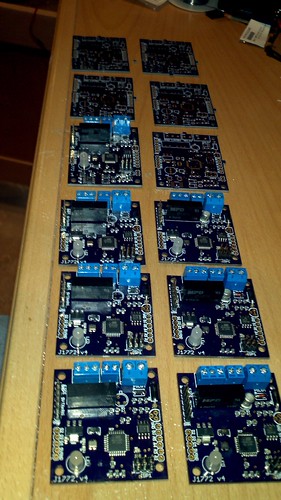
2011-12-13_20-49-21_851 by chris1howell, on Flickr
the GFCI boards...
No-GFCI boards will be $60 each. A relay\contactor, J1772 cable, and 12V regulated switch mode power supply is required.
The boards with GFCI will be $80 each. A relay\contactor, CT (CR Magnetics 8420-1000-g), J1772 cable, and 12V regulated switch mode is required.

2011-12-13_20-49-21_851 by chris1howell, on Flickr
Similar threads
- Replies
- 6
- Views
- 8K
- Replies
- 103
- Views
- 30K
- Replies
- 4
- Views
- 1K
- Replies
- 54
- Views
- 103K